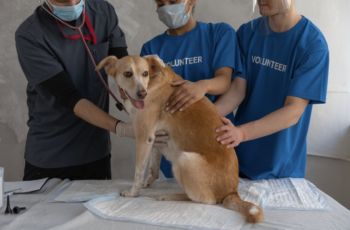Last updated:
Dogs provide their people with unconditional love, companionship, comfort, joy, laughter, and a host of other things we can’t put into words. We just know that they wag their tail in response to our smile and we gaze into their eyes, our hearts melt and all is right with the world.
For those experiencing Post Traumatic Stress Syndrome (PTSD) the benefits of canine companionship go above and beyond the mushy-gushy feelings we have for our canine partner. These highly skilled dogs provide people living with PTSD safety, freedom, and care that they cannot find elsewhere.
Psychiatric Service Dogs vs Emotional Support Animals
In 2020, the Department of Veteran Affairs published the results of a multi-year study comparing PTSD patients who were assigned an ESA versus a PSD. On a broad scale, the overall quantitative analysis pointed to both being beneficial with little difference between them.
However, when they drilled down into the specifics, they found two areas of profound change: PTSD symptoms and interpersonal interaction. People who had a PSD had a much greater increase in their interpersonal interaction and a much more significant decrease in the PTSD symptoms than those assigned an ESA. Some experienced such substantial relief that they reached a sub-clinical level of PTSD.
They hypothesize that the increase in interpersonal interaction could be due to a PSD’s freedom to go everywhere with their partner, whereas those with an ESA may avoid outings where their companion is not allowed to accompany them.
By performing tasks instead of only providing comfort, the person with a PSD has a trusted partner at their side. That bond can lighten the load of being hypervigilant and reduce symptoms of the flight or fight response.
Is a psychiatric service animal the answer to PTSD?
PTSD is a life-altering disability that anyone can experience.Victims of violent crimes and childhood abuse, people involved in mass shooting events, persons who have been physically violated, and even someone who experiences a horrific car accident may suffer from post traumatic stress syndrome. With varying causes and complexities, one solution does not fit all.
If you are experiencing PTSD, seek professional assistance. There are a number of treatments and strategies available. A Psychiatric Service Dog is just one of them.
Professional training is not required for a dog to become a PSD, but it is recommended. Some nonprofit organizations such as K9s For Warriors in Florida source service dogs from shelters and donors, train the dogs, match them with veterans, and tailor the tasks and training to each team. Many organizations offer financial assistance or provide these services at no cost.
To find out more about Psychiatric Service Dogs, check out Assistance Dogs International.
Levels of Service
Both Psychiatric Service Dogs (PSD) and Emotional Support Dogs (ESA), as well as your everyday average canine companion, have the potential to help people with PTSD, but their qualifications, skills, and legal rights vary widely.
Emotional Support Animals (ESA)
An ESA can be any animal from a gerbil to a peacock who provides comfort to their person by simply being. A medical professional needs to write a letter indicating the necessity of an ESA for the person’s treatment, but the animal need not go through any training.
While an ESA may enjoy being able to travel for free in most cases and often cannot be denied housing with their person, state and local laws along with individual businesses dictate the amount of freedom an ESA has to accompany their person in public.
Psychiatric Service Dogs (PSD)
A PSD can only be of the canine persuasion and is defined under the The American Disability Act’s as “any dog that is individually trained to do work or perform tasks for the benefit of an individual with a disability, including a physical, sensory, psychiatric, intellectual, or other mental disability.”
A PSD’s right to public access falls under the ADA’s requirement that “State and local government agencies, businesses, and non-profit organizations (covered entities) that provide goods or services to the public… make ‘reasonable modifications’ in their policies, practices, or procedures when necessary to accommodate people with disabilities.”
Just as ramps for people in wheelchairs need to be available for those utilizing them, so too does a “no pet policy” need to be waived so a person with a service dog may enter. A service dog may be denied entry only if their presence will “fundamentally alter” the nature of the activity or goods provided (think: service dog at a cat show).
Requirements of Service Animals
A Psychiatric Service Dog training begins by passing the AKC Good Citizen Test. Next, they should be able to pass the PAT (public access test), which levels up their excellence in safely navigating crowds, unaffected by the annoyances of a human-dominated world with startling noises, surprise reactions, and tempting treats. Once they have that foundation, they are prepared to learn specific skills for their person.
Common Skills and Tasks of the Psychiatric Service Dogs
Every person needs something slightly different, but the most frequent tasks include the following:
- Sense and Alert: While we may never understand what it is they’re experiencing, albeit hormones, a drop in blood sugar, a rise of blood pressure, or a shift in our energy field, the moment a PSD recognizes their person is having a difficulty, their work begins.
- Brace or Balance: When sensing imbalance or lightheadedness, they can provide physical support for stability.
- Pressure Comfort: Like a weighted blanket, when in the midst of a panic attack, the dog may lie or lean on their person.
- Sweep: The service dog will go into a crowded area before their person and return for the “all clear” to reduce the immediate anxiety the person feels in entering an unsecured public space.
- Navigation: A dog who is trained in crowd navigation finds the least stressful, most amount of space for their person to walk through without being triggered.
- Block: Dogs extend a person’s personal space, creating a bubble around them. They stand between the person and that which the person needs space from: other people, an object, or an event.
- Watch my back: The dog sits next to their person facing the opposite direction. With subtle cues like a tail wagging to indicate a friendly person approaching, they alleviate the stress of their person not being able to see behind them.
- Take to a safe space: If a person feels overwhelmed in a public setting, the dog can lead them to a safe, quiet place.
- Wake from nightmare: Dogs learn the subtle signals that their person is having a nightmare and wake them, giving those experiencing PTSD the peace to sleep without fear of traumatic dreams.
- Bring: A service dog can identify and retrieve learned objects such as a phone, medicine, or medical device. Service dogs are the ultimate second set of hands… with four paws and a muzzle.
The bond and love between a dog and their person can in and of itself, make a major contribution to the healing process. David Essex of Ray’s Hope Rescue finds that a service dog “gives the person purpose.” A service dog can’t sit in the corner like an unused mobility device. A service dog needs care and attention. They need to get up, get out the door, eat, move, play, and engage with the world. And by needing to do all those things, the person is compelled to grab the leash, follow along, and do exactly the same.



